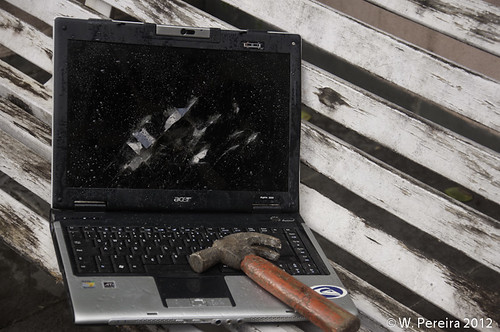Corporations spend billions of dollars each year repeating the same message over and over. It's called advertising and it works. A similar approach, according to a up-to-date Processor story, stands the best chance of slowing the never ending tide of stolen laptops: Keep telling employees that they have to guard their machines, and keep telling them how to do it.
Security, of course, is not at the forefront of every employee's mind. Indeed, habitancy take dumb chances. They leave machines unattended when they go to the rest room in a collective venue. They leave them lying on the front seat of an unlocked car when they run into a store. The theme of the Processor piece is that continually drilling best practices and corporate policies into the heads of employees may slowly mitigate this behavior. It's important because the question is so big: The Safeware assurance division reports that more than 600,000 machines are stolen annually. About .4 billion in possession information is lost, and 97 percent of the purloined machines are lost forever.
The story also provides advice on issues tangentially connected to stopping theft, such as the significance of administration systems to track machines and the use of strong passwords and other strategies to thwart criminals when they do succeed in stealing the machines.

The question of associates not even knowing if a motor is lost or stolen goes hand-in-hand with theft prevention. The centerpiece of a up-to-date Canadian Technology News story is a study by Absolute Software that spotlights some disturbing malfeasance by respondents: 62 percent say that missing computers aren't even noticed and an additional one 20 percent say that nothing is done about breaches.
Innovative tools are available, however. The bulk of the piece describes how Absolute Software tracks, manages and recovers wayward computers. The story provides a common-sense rationale for use of such software: Regardless of the impact it has on covering criminals, it is safe bet to chill internal theft simply because employees will know that it is there.
This Pc World story reports on a product that is ready in the Uk. It is a modern-day equivalent of the prologue from the old Mission: Impossible television show, in which the tape detailing the ridiculous assignment Jim and the gang will pull off in 60 minutes (minus commercials) starts burning seconds after delivery its message. In this case, Virtuity's BackStopp will wipe data off hard disks if the motor is taken from an unauthorized area. The watch is done via the Internet, Wi-Fi or Global system for movable communication or radio frequency identification if the laptop is turned off.
The story adds that if a motor has a Webcam, it can be instructed to take a photo of the presumptive thief and send it to the central office. The data destruction procedures, which meet standards set by the U.S. division of Defense's National market protection agenda Operating Manual, occur without alerting the thief.
A somewhat similar initiative, this one in India, is search Laptop from Unistal Systems. The software reports its location whenever it logs on. Thus, the owner or his or her business visit a Web portal to get a fix on a stolen machine. The It Nerd provides a lot of useful links: iAlertU, Laptop Alarm, Lojack For Laptops and, for physically securing a laptop, Kensington Cable. The writer concludes that the best way to stop laptop theft is cutting down the whole of time the motor is left unattended.
There is good news and bad news in all this. The good news is that there is a lot of technology aimed at securing, managing, looking and, when necessary, disabling laptops. The bad news is that there are many habitancy stealing laptops - and many corporate workers who are not paying attention.
instruction Key in Slowing Laptop Theft




